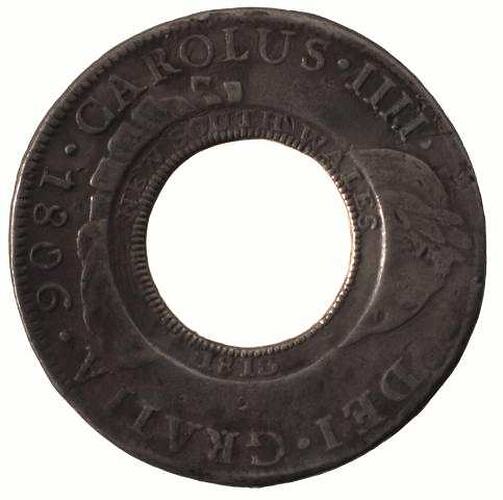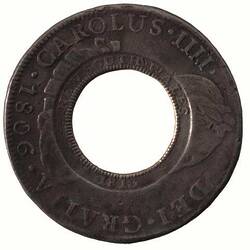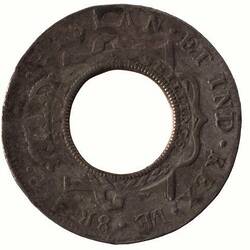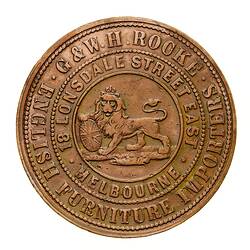Summary
5 Shilling 1813 Holey dollar, issued by New South Wales, Australia.
Artist was William Henshall and mint was Lima.
Host coin a Lima Mint 8 Real of 1806, J.P. Charles IIII , counterstamp dies I/A. Obverse die : I/7. Reverse die: A/12 (Spalding 165).
In 1813 Governor Lachlan Macquarie overcame an acute shortage of currency by arranging for the purchase of Spanish silver dollars, having the centres punched out and therein creating two new coins - the 'Holey Dollar' (valued at five shillings) and the 'Dump' (valued at one shilling and three pence). This doubled the number of coins in circulation and increased their total worth by 25 per cent. The work was carried out by William Henshall, a convict transported for forgery.
Physical Description
A ring shaped silver coin (40 mm diameter) manufactured by cutting a circular 'dump' from the centre of a Lima mint 8 real piece of 1806 and counterstamping the words NEW SOUTH WALES 1813 around the central hole on one side (the obverse) and the words FIVE + SHILLINGS on the other (the reverse) and a spray of leaves with the engraver's initial H. Obverse die : I/7. Reverse die: A/12 (Spalding 165).
Obverse Description
Overstruck around a circular hole cut from a Lima Mint 8 Real coin, NEW SOUTH WALES 1813, around the rim of the original coin CAROLUS IIII DEI GRATIA 1782. This was the obverse of the host coin and featured a laureate bust of Charles IIII (mostly removed with the central dump) facing right.
Reverse Description
Overstruck around a circular hole cut from a Lima Mint 8 Real coin, FIVE + SHILLINGS, around the rim of the original coin LIMA (as a monogram) 8 R J.P. HISPAN. ET IND. REX. This was the reverse of the host coin and featured a crowned shield of Spain supported by the pillars (mostly removed with the central dump). At the bottom of the overstrike is a spray of olive leaves with the artist's initial H at its centre.
Edge Description
Circle & rectangle pattern
More Information
-
Collection Names
-
Collecting Areas
-
Acquisition Information
Transfer from National Gallery of Victoria (NGV), Mr Alfred Chitty, 15 Mar 1976
-
Date Issued
1813 AD
-
Issued By
-
Mint
-
Artist
-
Previous Collection
-
Inscriptions
Obverse: NEW SOUTH WALES 1813 CAROLUS IIII DEI GRATIA 1806 Reverse: FIVE + SHILLINGS H LIMA 8 R J.P. HISPANIA ET IND REX
-
Denomination
-
Series
-
Material
Silver
-
Axis
12
-
Classification
-
Category
-
Discipline
-
Type of item
-
Overall Dimensions
39 mm (Outside Diameter), 20.176 g (Weight)
-
Shape
Round with hole
-
References
References: Mira Noble No. 1806/9. Spalding No.165.
[Book] Mira, William J. & Noble, W J. 1988. The Holey Dollars of New South Wales., No.1806/9
-
Keywords



